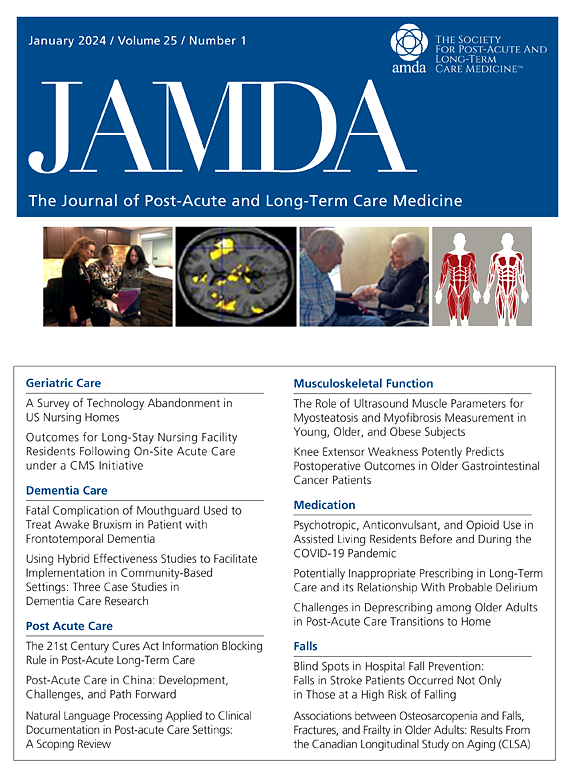Determinants of Mortality and Causes of Death in Patients With Dementia and Very Severe Challenging Behavior
IF 4.2
2区 医学
Q2 GERIATRICS & GERONTOLOGY
Journal of the American Medical Directors Association
Pub Date : 2025-06-25
DOI:10.1016/j.jamda.2025.105713
引用次数: 0
Abstract
Objectives
To gain insight into the mortality over time of patients with very severe challenging behavior in dementia when they are temporarily admitted to highly specialized units for treating the behavior.
Design
Observational study.
Setting and Participants
Eleven highly specialized units throughout the Netherlands participated from December 2020 until December 2022, with a follow-up in September 2023, with 127 patients participating.
Methods
General clinical characteristics were collected, such as demographics and cognitive functioning, behavior during the first 2 weeks assessed by the Cohen-Mansfield Agitation Inventory (CMAI) and the Neuropsychiatric Inventory Questionnaire (NPI-Q), date of death, and cause of death. Two Cox regression models were estimated, namely prediction models to describe the relationship between some (regular) determinants and mortality over time and association models between behavioral factors and mortality.
Results
Of the 127 participants, one-third died during their stay. The most prevalent causes of death were dehydration (often with cachexia) and pneumonia. Mortality over time is best predicted by age (ie, being 80 years or older) and the number of non-psychotropic drugs, as a proxy for somatic disease burden. The 10% of patients scoring highest on the CMAI factor of physically aggressive behavior had a ninefold increased mortality risk during their stay.
Conclusions and Implications
A considerable number of patients with very severe challenging behavior in dementia admitted to highly specialized units died during their stay, with a ninefold increased mortality risk over time found in patients with very severe physical aggression. This underlines the need to devote attention to suitable terminal palliative care in clinical practice and research in this patient group.
痴呆和非常严重的挑战行为患者死亡的决定因素和原因。
目的:深入了解具有非常严重的挑战性行为的痴呆症患者在被临时收治到高度专业化的治疗单位时的死亡率。设计:观察性研究。环境和参与者:从2020年12月到2022年12月,荷兰11个高度专业化的单位参与了研究,并于2023年9月进行了随访,共有127名患者参与。方法:收集患者的一般临床特征,如人口统计学和认知功能、Cohen-Mansfield躁动量表(CMAI)和神经精神量表(NPI-Q)评估患者前2周的行为、死亡日期和死亡原因。估计了两个Cox回归模型,即描述某些(常规)决定因素与死亡率之间随时间变化关系的预测模型和行为因素与死亡率之间的关联模型。结果:在127名参与者中,三分之一的人在住院期间死亡。最常见的死亡原因是脱水(常伴有恶病质)和肺炎。随着时间的推移,死亡率最好通过年龄(即80岁或以上)和非精神药物的数量来预测,作为躯体疾病负担的代理。在身体攻击行为的CMAI因素中得分最高的10%的患者在住院期间死亡风险增加了9倍。结论和意义:相当多的患有非常严重的挑战性行为的痴呆症患者在住院期间死亡,随着时间的推移,发现非常严重的身体攻击患者的死亡率增加了9倍。这强调需要在临床实践和研究中关注合适的晚期姑息治疗。
本文章由计算机程序翻译,如有差异,请以英文原文为准。
求助全文
约1分钟内获得全文
求助全文
来源期刊
CiteScore
11.10
自引率
6.60%
发文量
472
审稿时长
44 days
期刊介绍:
JAMDA, the official journal of AMDA - The Society for Post-Acute and Long-Term Care Medicine, is a leading peer-reviewed publication that offers practical information and research geared towards healthcare professionals in the post-acute and long-term care fields. It is also a valuable resource for policy-makers, organizational leaders, educators, and advocates.
The journal provides essential information for various healthcare professionals such as medical directors, attending physicians, nurses, consultant pharmacists, geriatric psychiatrists, nurse practitioners, physician assistants, physical and occupational therapists, social workers, and others involved in providing, overseeing, and promoting quality

 求助内容:
求助内容: 应助结果提醒方式:
应助结果提醒方式:


